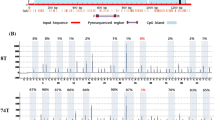Abstract
Lung cancer is the leading cause of cancer-related deaths worldwide and is usually associated with a late diagnosis and a poor prognosis. Thymosin β10 (TMSB10) is a monomeric actin sequestering protein that regulates actin cytoskeleton organization. The aberrant TMSB10 expression has been implicated in the pathogenesis of human cancers. However, its role in carcinogenesis is still controversial. To better understand the role of TMSB10 in lung tumorigenesis and its regulatory mechanism, we examined the methylation status and expression of the TMSB10 gene in non-small cell lung cancers (NSCLCs) using methylation-specific PCR (MSP) and immunohistochemistry (IHC), respectively. MSP analysis showed that the TMSB10 promoter was already unmethylated in most tumor tissues and became demethylated in 20 (14.4%) of the 139 NSCLCs. TMSB10 hypomethylation was not significantly correlated with the clinicopathological features. IHC showed that the TMSB10 protein was strongly expressed in the cytoplasm of malignant cells and its overexpression was detected in 50.0% of the tumor tissues compared to normal tissues. TMSB10 overexpression was frequently observed in sqaumous cell carcinomas compared to adenocarcinomas with border line significance (P = 0.072). However, TMSB10 methylation status was not linked to its overexpression. Collectively, these results suggest that TMSB10 hypomethylation may be a frequent event in NSCLCs, but it may not be a common mechanism underlying TMSB10 overexpression. However, further studies with large numbers of patients are needed to confirm our findings.
Similar content being viewed by others
References
Alberg, A.J., Brock, M.V., and Samet, J.M. (2005). Epidermiology of lung cancer: looking to the future. J. Clin. Oncol. 23, 3175–3185.
Baylin, S.B., and Herman, J.G. (2000). DNA hypermethylation in tumorigenesis: epigenetics joins genetics. Trends Genet. 16, 168–174.
Belinsky, S.A. (2004). Gene-promoter hypermethylation as a biomarker in lung cancer. Nat. Rev. Cancer 4, 1–11.
Califano, D., Monaco, C., Santelli, G., Giuliano, A., Veronese, M.L., Berlingieri, M.T., de Franciscis, V., Berger, N., Trapasso, F., Santoro, M., et al. (1998). Thymosin beta-10 gene overexpression correlated with the highly malignant neoplastic phenotype of transformed thyroid cells in vivo and in vitro. Cancer Res. 58, 823–828.
Cho-Vega, J.H., Tsavachidis, S., Do, K.A., Nakagawa, J., Medeiros, L.J., and McDonnell, T.J. (2007). Dicarbony/L-xylulose reductase: a potential biomarker identified by laser-capture microdis section-micro serial analysis of gene expression of human prostate adenocarcinoma. Cancer Epidemiol. Biomarkers Prev. 16, 2615–2622.
Erickson-Viitanen, S., Ruggieri, S., Natalini, P., and Horecker, B.L. (1983). Thymosin beta 10, a new analog of thymosin beta 4 in mammalian tissues. Arch. Biochem. Biophys. 225, 407–413.
Gu, Y., Wang, C., Wang, Y., Qui, X., and Wang, E. (2009). Expression of thymosin beta 10 and the role in non-small lung. Hum. Pathol. 40, 117–124.
Hall, A.K. (1995). Thymosin beta-10 accelerates apoptosis. Cell. Mol. Biol. Res. 41, 167–180.
Janne, P.A., Engelman, J.A., and Johnson, B.E. (2005). Epidermal growth factor receptor mutations in non-small cell lung cancer: implications for treatment and tumor biology. J. Clin. Oncol. 23, 3227–3234.
Jones, P.A., and Baylin, S.B. (2002). The fundamental role of epigenetic events in cancer. Nat. Rev. Genet. 3, 415–428.
Kee, S.K., Lee, J.Y., Kim, M.J., Lee, S.M., Jung, Y.W., Kim, Y.J., Park, J.Y., Bae, H.I., Hong, H.S., Yun, Y.K., et al. (2007). Hypermethylation of the Ras Association domain family 1A (RASSF1A) gene in gallbladder cancer. Mol. Cells 24, 364–371.
Kim, D.S., Cha, S.I., Lee, J.H., Lee, Y.M., Choi, J.E., Kim, M.J., Lim, J.S., Lee, E.B., Kim, C.H., Park, T.I., et al. (2007). Aberrant DNA methylation profiles of non-small cell lung cancers in a Korean population. Lung Cancer 58, 1–6.
Kim, D.S., Kim, M.J., Lee, J.Y., Lee, S.M., Choi, J.E., Lee, S.Y., and Park, J.Y. (2009). Epigenetic inactivation of checkpoint kinase 2 gene in non-small cell lung cancer and its relationship with clinicopathological features. Lung Cancer 65, 247–250.
Lee, S.H., Zhang, W., Choi, J.J., Cho, Y.S., Oh, S.H., Kim, J.W., Hu, L., Xu, J., Liu, L., and Lee, J.H. (2001). Overexpression of the thymosin beta-10 gene in human ovarian cancer cells disrupts F-actin stress fiber and leads to apoptosis. Oncogene 20, 6700–6706.
Lee, S.H., Son, M.J., Oh, S.H., Rho, S.B., Park, K., Kim, Y.J., Park, M.S., and Lee, J.H. (2005). Thymosin β10 inhibits angiogenesis and tumor growth by interfering with Ras function. Cancer Res. 65, 137–147.
Leondiadis, L., Livaniou, E., Vassiliadou, I., Ferderigos, N., Ithakissios, D.S., and Evangelatos, G.P. (1996). Development of specific anti-thymosin β10 antipeptide antibodies for application in immunochemical techniques. Peptides 17, 1091–1096.
Liu, C.R., Ma, C.S., Ning, J.Y., You, J.F., Liao, S.L., and Zheng, J. (2004). Differential thymosin β10 expression levels and actin filament organization in tumor cell lines with different metastatic potential. Chin. Med. J. 117, 213–218.
McDoniels-Silvers, A.L., Nimri, C.F., Stoner, G.D., Lubet, R.A., and You, M. (2002). Differential gene expression in human lung adenocarcinomas and squamous cell carcinomas. Clin. Cancer Res. 8, 1127–1138.
Pedersen, M.W., Thykjaer, T., Orntoft, T.F., Damstrup, L., and Poulsen, H.S. (2001). Profile of differentially expressed genes mediated by the type III epidermal growth factor receptor mutation expressed in a small-cell lung cancer cell line. Br. J. Cancer 85, 1211–1218.
Santelli, G., Califano, D., Chiappetta, G., Vento, M.T., Bartoli, P.C., Zullo, F., Trapasso, F., Viglietto, G., and Fusco, A. (1999). Thymosin β-10 gene overexpression is a general event in human carcinogenesis. Am. J. Pathol. 155, 799–804.
Sribenja, S., Li, M., Wongkham, S., Wongkham, C., Yao, Q., and Chen, C. (2009). Advances in thymosin β10 research: differential expression, molecular mechanisms, and clinical implications in cancer and other conditions. Cancer Invest. 27, 1016–1022.
Tsou, J.A., Hagen, J.A., Carpenter, C.L., and Laird-Offringa, I.A. (2002). DNA hypermethylation analysis: a powerful new tool for lung cancer diagnosis. Oncogene 21, 5450–5461.
Author information
Authors and Affiliations
Corresponding authors
About this article
Cite this article
Lee, S.M., Na, Y.K., Hong, H.S. et al. Hypomethylation of the thymosin β10 gene is not associated with its overexpression in non-small cell lung cancer. Mol Cells 32, 343–348 (2011). https://doi.org/10.1007/s10059-011-0073-z
Received:
Revised:
Accepted:
Published:
Issue Date:
DOI: https://doi.org/10.1007/s10059-011-0073-z




